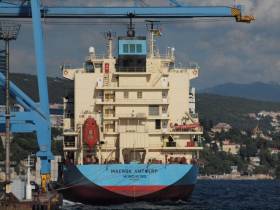Displaying items by tag: Sistership of Maersk Alabama
#CaptainPhillips – Containership Antwerp which departed Dublin Port this morning, is a sister of Maersk Alabama which Somali pirates hijacked in 2009 and where the film 'Captain Phillips' is based from, writes Jehan Ashmore.
The 14,120 tonnes Maersk Alabama is the leadship and namesake of this containership class and is reputed to be the first U.S. cargoship to be hijacked in two hundred years. The pirates took over the 155m long containership under the command of Captain Richard Phillips. In the 2013 film, his character was played by actor Tom Hanks.
Only a year separates the 1998 built Maersk Alabama from the Maersk Antwerp which was renamed in recent years. The 1,058 TEU containership made the first ever direct call to Dublin Port yesterday for the Maersk Group subsidiary, Seago Line on the new UK (Liverpool)-Ireland-Spain (Algeciras) service.
The Antwerp which is one of the larger containerships to call to Dublin, departed this morning to begin in completing the first round trip of the new service. This involves the third and final leg which is bound for the southern Spanish port located west of Gibraltar.























